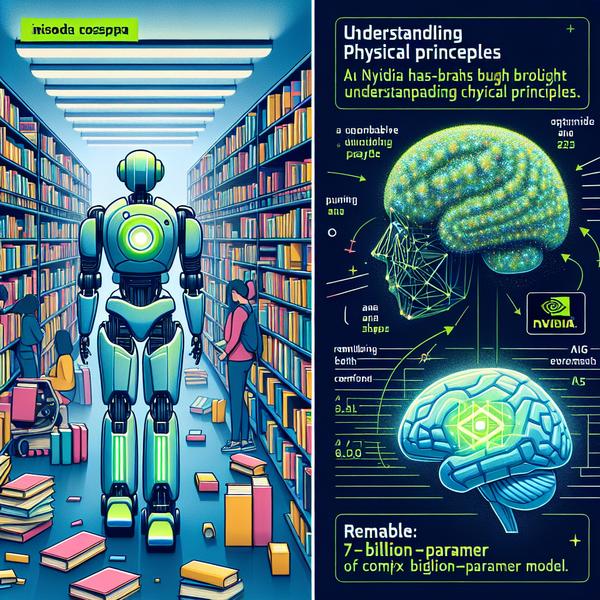
Nvidia has unveiled groundbreaking advancements at SIGGRAPH 2025, including their innovative Cosmos physical AI models, enhanced simulation libraries, and comprehensive AI stacks. These developments are set to revolutionize robotics, autonomous vehicles, and industrial sectors by making physical AI smarter, faster, and more accessible for real-world applications. With advanced tools for data simulation, model training, and seamless integration, Nvidia’s Cosmos and Omniverse bring the digital and physical worlds closer, enabling the next leap forward in robotics and AI-powered systems.
Building Smarter Robots with Cosmos Reason
- Cosmos Reason is a 7-billion-parameter AI model that equips robots with human-like reasoning abilities. Think of it as a brain for machines, built to handle real-world challenges.
- Robots using Cosmos Reason can remember what they've “seen” before, plan step-by-step actions intelligently, and even understand physical principles like gravity or object motion. This makes them adaptable to complex environments like warehouses or busy streets.
- For example, imagine a robot navigating a crowded library to organize books. Cosmos Reason processes visual data from cameras and combines it with its understanding of spatial organization to find the right shelves without bumping into obstacles.
- This model isn’t just for robots; it can also analyze videos or curate data where a clearer understanding of physical context is needed. It's akin to teaching a robot to "think before it acts."
Turbocharging AI Training with Cosmos Transfer
- One of the coolest parts of Nvidia's new tech is Cosmos Transfer-2. It’s like a data generator for AI, creating hyper-realistic scenarios for machines to train on, long before they step into the real world.
- Think about self-driving cars. Instead of taking a car out in different weather conditions or tricky road setups, Cosmos Transfer creates these scenarios virtually. This cuts costs and speeds up training dramatically.
- The Distilled Transfer variant further accelerates the process. Developers can tweak, adapt, and create synthetic data swiftly, which is useful when experimenting with new robot designs or AI systems that need tailored datasets.
- For instance, a delivery drone could be fine-tuned to handle narrow alleyways or busy urban traffic based on these virtual data models, ensuring it performs flawlessly when deployed.
Shaping Virtual Worlds for Learning with Omniverse
- Omniverse, Nvidia’s simulation platform, is like a sandbox where developers can create lifelike, virtual versions of real-world environments.
- Using Neural Reconstruction Libraries, developers can turn sensor data, like 3D scans of a room, into stunning photorealistic simulations. This is incredibly useful for robotics engineers looking to test how their machines interact with objects or navigate spaces.
- Omniverse now integrates with tools like OpenUSD and CARLA Simulator, making it easier to standardize simulations across projects. It’s like building a universal language for AI training environments.
- As an example, robotics companies could use these tools to train their machines in everything from slippery factory floors to cluttered house interiors—all within a virtual world.
Infrastructure Tailored for AI Workflows
- Creating smarter AI requires powerful infrastructure, and Nvidia’s new RTX Pro Blackwell Servers are purpose-built for this. These servers handle simulation, model training, and deployment from one unified platform.
- On top of that, Nvidia’s DGX Cloud lets AI engineers work together remotely. Imagine a team spread across the globe, instantly accessing the same AI resources and managing projects seamlessly through the cloud.
- This kind of setup reduces barriers for smaller companies, letting them compete in the tech world without needing massive hardware investments upfront.
- For instance, a startup wanting to develop warehouse robots no longer needs an expensive server room—they can scale their operations through Nvidia's cloud services.
Real-World Impact: Accelerating Deployment
- Nvidia’s innovations aren’t just limited to theory. Tech giants like Amazon Devices, Boston Dynamics, and Uber are already piloting these tools to build better robots, digital twins, and smart vehicles.
- A digital twin, for instance, is a virtual copy of a physical object or environment. Using Nvidia’s Cosmos, companies are recreating real factories or city blocks to test and optimize their AI systems before deploying them.
- Cosmos models also come with permissive licenses, allowing both researchers and businesses to adapt the technology for their needs—be it groundbreaking research or commercial product designs.
- This open-access approach might just redefine how industries adopt and scale AI, speeding up innovation across transportation, logistics, and beyond.